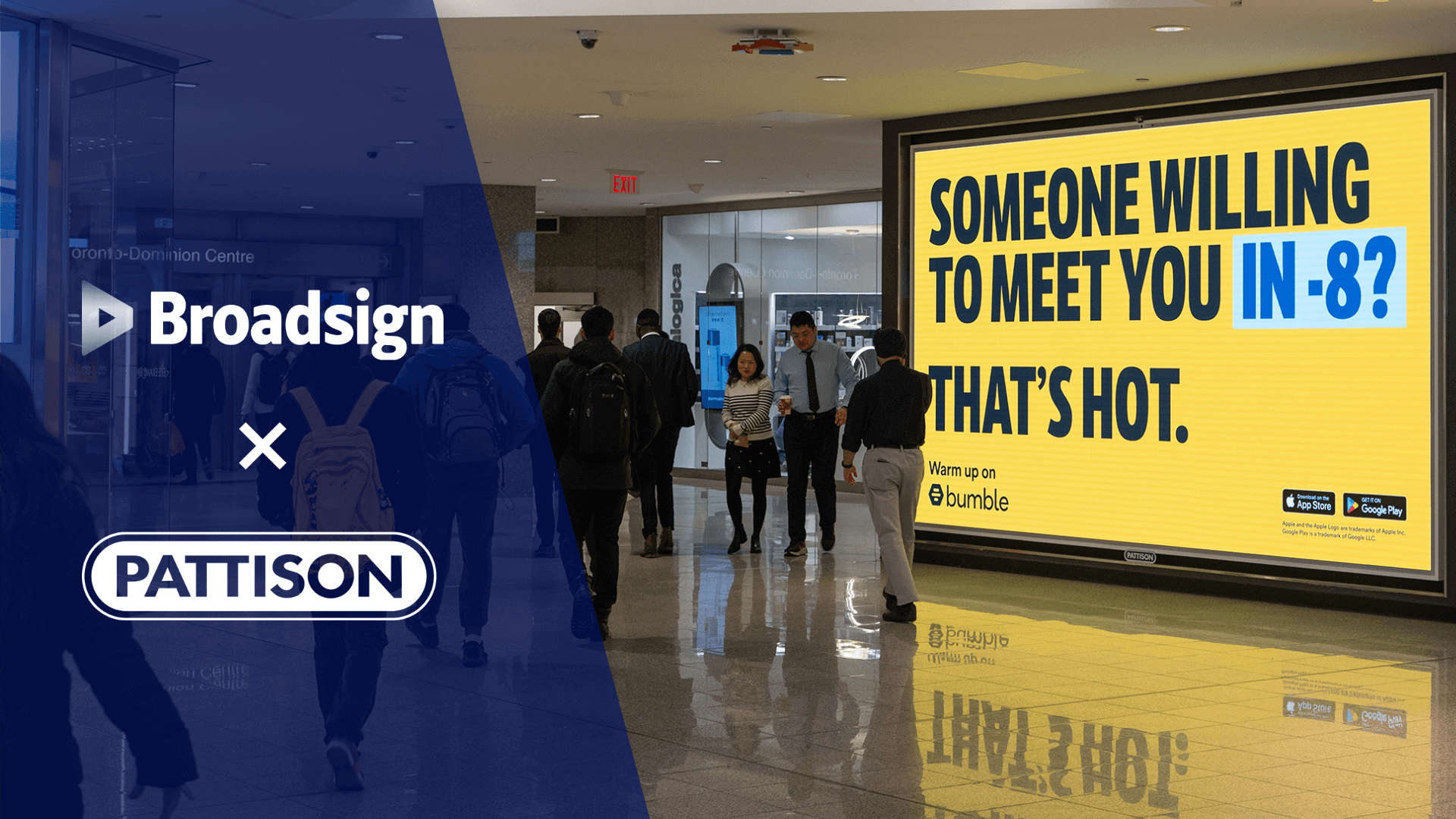| October 11, 2021
PATTISON Modernizes its Out-of-Home Technology Stack with Broadsign
Partnership streamlines daily operations and unlocks new revenue potential; enables PATTISON clients to maximize OOH campaigns
Montreal, Canada, April 25, 2024 – Out-of-home (OOH) ad tech leader Broadsign today announced that PATTISON Outdoor Advertising, a leading Canadian OOH media owner, has adopted the full Broadsign OOH technology stack. With Broadsign already providing a centralized hub for its programmatic digital OOH (DOOH) workflows, the expanded partnership now enables PATTISON to dynamically manage and optimize its OOH inventory to unlock previously untapped revenue opportunities. The partnership also opens up new ways for brands to book campaigns on PATTISON inventory with a more targeted, impression-based approach and accelerates the rate at which PATTISON can display client ads across its OOH inventory, spanning urban pathways, residential and office buildings, transit hubs, airports, and other venues across Canada.
Providing a near real-time ad scheduling workflow comprising advanced optimization and prioritization tools, the Broadsign platform is helping PATTISON reallocate time previously spent on manual campaign pacing and adding daily plays to bump up the delivery of low-pacing campaigns. Broadsign’s optimization engine works on a play-by-play or impression level based on each campaign’s goals, and enables PATTISON’s sales team to easily find more available inventory, even in high sellout periods. With the updated OOH platform, PATTISON can now easily customize campaigns to align with client needs. Since beginning its rollout of the new platform in early March, it has powered OOH campaigns for some of PATTISON’s largest clients, including Holt Renfrew, Lotto Quebec, McDonald’s, and Tim Hortons.
“In evaluating our options, the Broadsign tech stack quickly emerged as the best fit, especially for our ad-serving needs. It lets us maximize yield and revenue potential while ensuring pDOOH campaigns can be seamlessly executed based on client goals, with little to no manual intervention,” shared PATTISON Director of Digital Innovation Jessica Littlejohn. “Our digital product offering has never been more robust than with Broadsign at its core, and our team has more time to do what we do best – understand and help our clients achieve their objectives.”
Echoing Littlejohn’s sentiments, PATTISON President Steve McGregor, added, “The support the Broadsign team has provided along the journey has been instrumental in helping us to achieve our business goals and prepare for our next phase of growth.”
“PATTISON is an industry trailblazer with a reputation for always being one step ahead of the curve. It was one of the first media owners to offer full-scale programmatic DOOH and advanced audience-based targeting options,” shared Maarten Dollevoet, Chief Revenue Officer, Broadsign. “PATTISON’s commitment to evolving its digital toolset to prepare for the next wave of OOH is inspiring, and we’re excited to partner with them to help them reach their goals.”
About Broadsign
Broadsign empowers media owners, agencies, and brands to harness the power and reach of out-of-home to connect with audiences in ways unlike any other advertising channel. More than 1.5 million static and digital signs along roadways and in airports, shopping malls, retailers, health clinics, transit systems, electric vehicle charging stations, and more run on Broadsign, reaching audiences at multiple touchpoints throughout the consumer journey. The Broadsign Platform helps media owners such as Outfront, Pattison Outdoor, Global, and Intersection streamline business operations and maximize revenue opportunities while enabling marketers and agencies to more easily plan and execute dynamic OOH campaigns that resonate with audiences. Brands spanning AB InBev, Disney, FanDuel, H&M, Honda, HP, Johnson & Johnson, KLM, Uber Eats, Sea-Doo, Samsonite, and many more have run successful programmatic DOOH campaigns enabled by Broadsign technology. https://broadsign.com
About PATTISON
PATTISON Outdoor Advertising, a division of The Jim Pattison Group is Canada’s largest Out-of-Home advertising company. PATTISON Outdoor helps brands and businesses harness the power of Out-of-Home advertising by providing the most comprehensive range of products, markets, insights and customer support services. With its roots reaching back to 1908, PATTISON has been providing innovative solutions for Out-of-Home advertising opportunities with products ranging from traditional billboards to transit, digital, airport, residential, office, and street level formats. PATTISON is headquartered in Toronto, Ontario with over 25 sales offices across the country, providing advertisers unmatched reach and coverage with products available in over 200 markets coast to coast.

